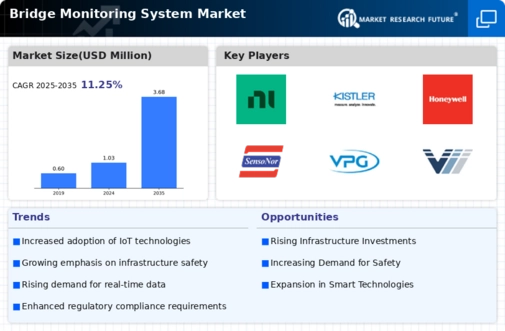Regulatory Pressures
The Bridge Monitoring System Market is influenced by stringent regulatory requirements aimed at ensuring the safety and reliability of infrastructure. Governments are implementing more rigorous standards for bridge inspections and maintenance, necessitating the adoption of advanced monitoring systems. Compliance with these regulations is becoming increasingly critical, as failure to adhere can result in severe penalties and public safety risks. As regulatory frameworks evolve, the demand for effective bridge monitoring solutions is expected to rise, compelling organizations to invest in technologies that facilitate compliance. This trend underscores the importance of the Bridge Monitoring System Market in helping stakeholders meet regulatory demands while enhancing overall infrastructure safety.
Growing Safety Concerns
Safety remains a paramount concern in the Bridge Monitoring System Market, particularly as aging infrastructure poses risks to public safety. The increasing frequency of bridge failures and accidents has prompted authorities to prioritize monitoring systems that can detect structural issues before they escalate. Recent statistics indicate that a significant percentage of bridges worldwide are in need of repair or replacement, highlighting the urgency for effective monitoring solutions. This growing awareness of safety risks is likely to propel the demand for bridge monitoring technologies, as stakeholders seek to implement proactive measures to safeguard public infrastructure. Consequently, the Bridge Monitoring System Market is poised for growth as it addresses these critical safety challenges.
Technological Advancements
The Bridge Monitoring System Market is being transformed by rapid technological advancements. Innovations such as Internet of Things (IoT) sensors, artificial intelligence, and machine learning are revolutionizing the way bridge conditions are monitored and assessed. These technologies enable real-time data collection and analysis, allowing for more accurate predictions of structural integrity. As a result, stakeholders are increasingly adopting these advanced monitoring systems to enhance maintenance strategies and reduce costs. The integration of such technologies is expected to drive market growth, as organizations recognize the value of data-driven decision-making in maintaining bridge safety and performance. The Bridge Monitoring System Market is thus likely to see a significant uptick in demand for these cutting-edge solutions.
Increased Infrastructure Investment
The Bridge Monitoring System Market is experiencing a surge in demand due to heightened investments in infrastructure. Governments and private entities are allocating substantial budgets to enhance transportation networks, which includes the construction and maintenance of bridges. According to recent data, infrastructure spending is projected to reach trillions of dollars over the next decade, emphasizing the need for effective monitoring systems. This investment trend is likely to drive the adoption of advanced bridge monitoring technologies, ensuring safety and longevity. As infrastructure projects proliferate, the Bridge Monitoring System Market stands to benefit significantly from the integration of innovative monitoring solutions that can provide real-time data and analytics, thereby improving decision-making processes.
Environmental Sustainability Initiatives
The Bridge Monitoring System Market is also being shaped by a growing emphasis on environmental sustainability. As concerns about climate change and ecological impact intensify, there is a push for infrastructure solutions that minimize environmental footprints. Bridge monitoring systems that utilize energy-efficient technologies and promote sustainable practices are gaining traction. This shift towards sustainability is likely to drive innovation within the market, as companies seek to develop monitoring solutions that align with environmental goals. The integration of sustainable practices in the Bridge Monitoring System Market not only addresses regulatory pressures but also appeals to a more environmentally conscious public, potentially expanding market opportunities.























Leave a Comment